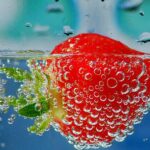 There’s nothing like the feeling of crisp, fresh, pure water as it slides down your throat, cooling you off on a hot day, or the invigoration of a shower first thing in the morning. Water makes up an amazing two-thirds of our body mass and is vital to many aspects of our health.
There’s nothing like the feeling of crisp, fresh, pure water as it slides down your throat, cooling you off on a hot day, or the invigoration of a shower first thing in the morning. Water makes up an amazing two-thirds of our body mass and is vital to many aspects of our health.
Inside the body, water acts to stabilize body temperature and it takes part in digestion, blood circulation, absorption and use of nutrients, building new tissue, lubricating the joints and nervous system, and carrying wastes out of the body.
We lose an average of 3 quarts of water a day through perspiration and elimination, and up to 10 quarts daily with strenuous exercise or in desert climates. Water must be frequently replaced to prevent dehydration.
Despite the critical role water plays in our health, the Environmental Protection Agency warns that dozens of substances contained in public drinking water can cause infection and other illness (1). Rain falls through polluted air containing bacteria, smoke, and chemicals.
Our soils contain pesticides, herbicides (weed killers), fertilizers, and many other chemicals that wash into the rivers, lakes and streams — the primary sources of our tap water. Radioactive wastes and poisons from factories (arsenic, etc.) are poured into water supplies.
Chlorine is universally added to public drinking water as a disinfectant. Drinking chlorinated water has been found to promote illness according to the British Medical Journal “The Lancet.” (2).
Fluoride is frequently added to city tap water. The largest study ever done on the effect of fluoride on dental cavities took place in India over the course of 30 years. After much study, the researchers concluded that cavities are actually caused by a high fluoride intake from drinking water and a low consumption of dietary calcium (5). Fluoride can also contribute to hip fractures in older women and men (6).
Showering
New research has uncovered that drinking polluted tap water is far from the only way people are exposed to dangerous substances. According to New Scientist Magazine, taking long hot showers is a serious health risk. During the shower, the chemicals evaporate out of the water and are inhaled into the lungs and absorbed through the skin. This delivers up to 100 times more chlorine to the person than if they drank the water — and directly into the bloodstream (7).
Pure Water
Water filters, purifiers and distillers are available for the home that can turn toxin-filled tap water into healthy water for drinking and bathing. Shower and bath filters generally do a good job of removing pollutants from the water, and good kitchen models are available for the countertop, under the sink, and refrigerator.
Look for kitchen filters that are certified by NSF International (The National Sanitation Foundation) or that meet EPA (Environmental Protection Agency) standards. Choose a shower filter based on how many gallons of water it can clean.
Raw fruits and vegetables are especially good sources of chemically pure water, which is 100 percent pure hydrogen and oxygen. Plants “distill” the water they consume and convert inorganic minerals from the environment into organic minerals, which our bodies can better assimilate (8). Because tap water only contains minimal amounts of minerals, it should not be used as one’s primary source of minerals.
A good supplement should be taken that provides a full spectrum of minerals from a plant-based source. Especially if you drink distilled water, which has had all of the minerals removed from it. Distilled water and reverse osmosis water are, however, good sources of healthy, clean water. There are also many good water filters and filtering systems on the market to choose from. Keep pure water with you at all times and drink several glasses each day. Also include raw fruits and vegetables in your diet for the pure water and minerals they contain.
Protect yourself and your family from toxic water, and supply your body with the clean, pure water it deserves — both inside and out.
A short glossary of water terms:
GAC: Granulated activated carbon filter
KDF: A filtering medium by KDF Fluid Treatment, Inc. that removes contaminants.
MCL: Maximum contaminant level
PCB’s: Polychlorinated Biphenyls — A highly toxic pesticide made from chlorine
PPB: Parts per billion
PPM: Parts per million
THM’s: Trichlorethanes — Cancer-causing byproducts of chlorine
VOC: Volatile Organic Compound
REFERENCES:
1. Drinking Water Standards and Health Advisories, Office of Water, U.S. Environmental Protection Agency, Wash, D.C., Summer 2000
2. Lancet, 5 December 98, Volume 352, Number 9143 and Lancet 23 August 97, Volume 350, Number 9077
3. American Museum of Natural History: Epidemic, 1993: Cryptosporidiosis In Milwaukee
4. Effect of monochloramine disinfection of municipal drinking water on risk of nosocomial Legionnaires’
disease, The Lancet, Volume 353, Number 9149, 23 January 1999
5. Teotia SPS, Teotia M, Dental caries: a disorder of high fluoride and low dietary calcium interactions (30 years
of personal research), Fluoride, 1994 April, 27:2, 59-66
6. Agency for Toxic Substances and Disease Registry (ATSDR). Toxicological Profile for Fluorides, Hydrogen Fluoride, and Fluorine. US Department of Health and Human Services, Public Health Service. 1991; ATSDR/TP-91/17.
7. New Scientist Magazine, 18 Sept. 1986
8. Nutrition Almanac, McGraw-Hill Books


